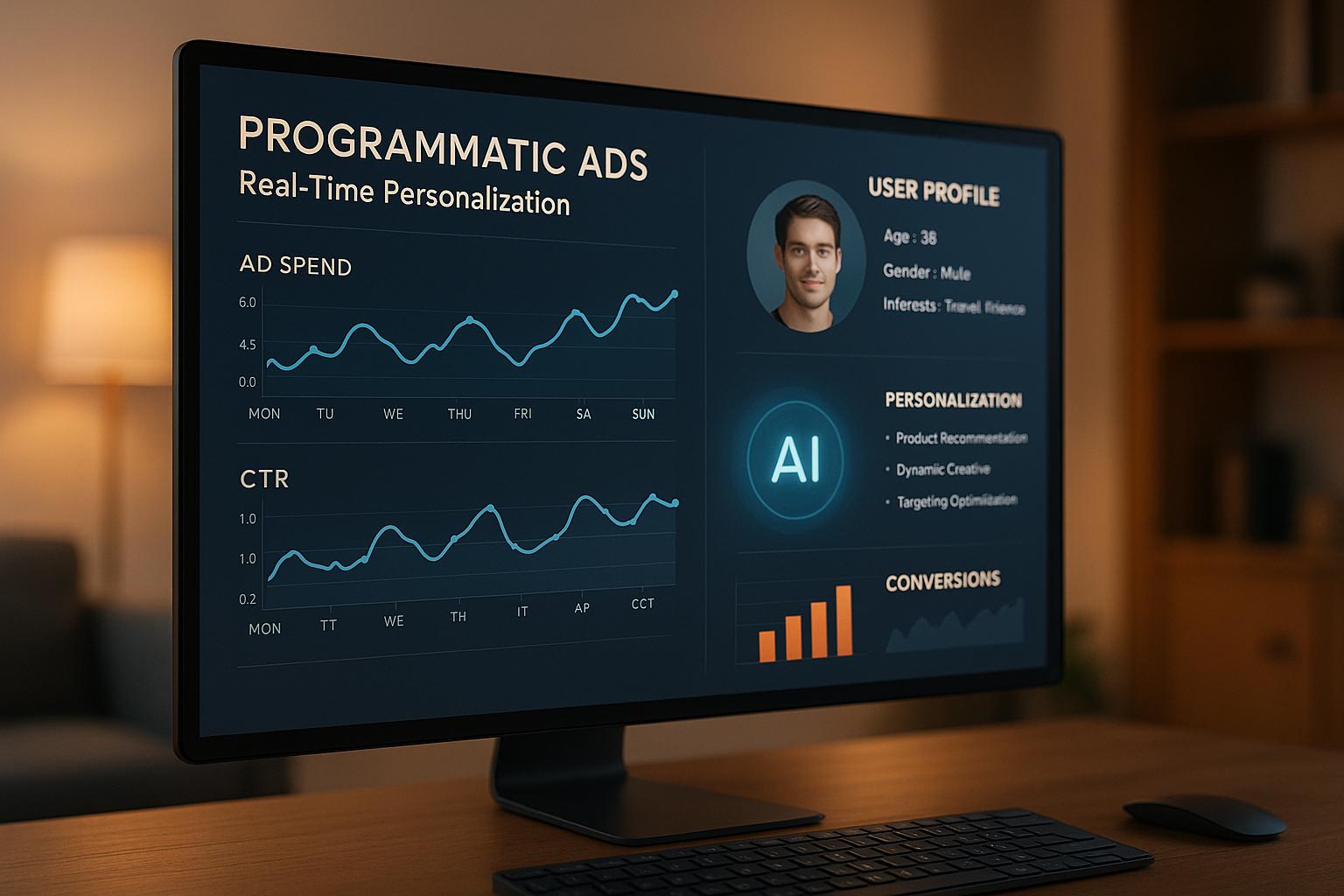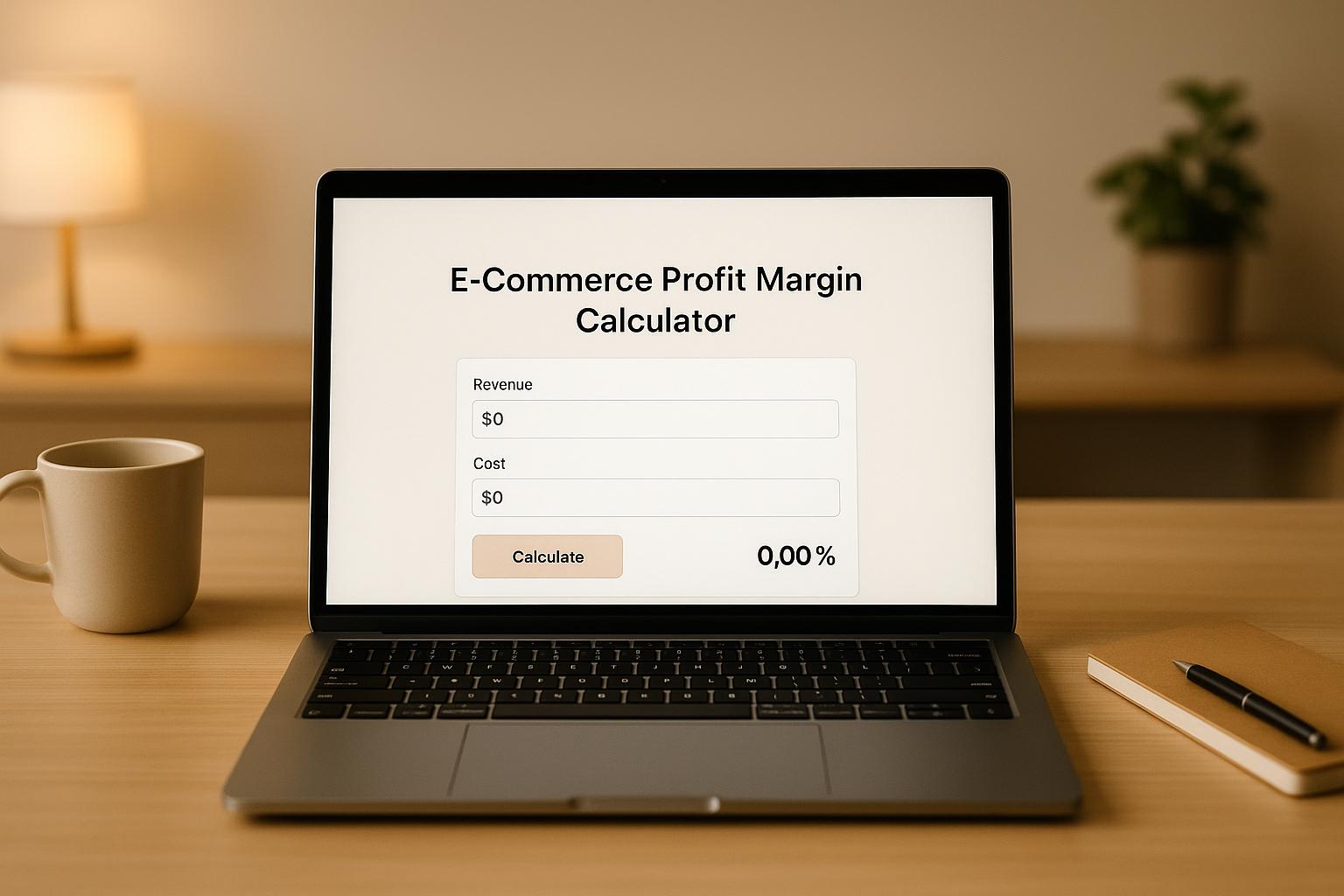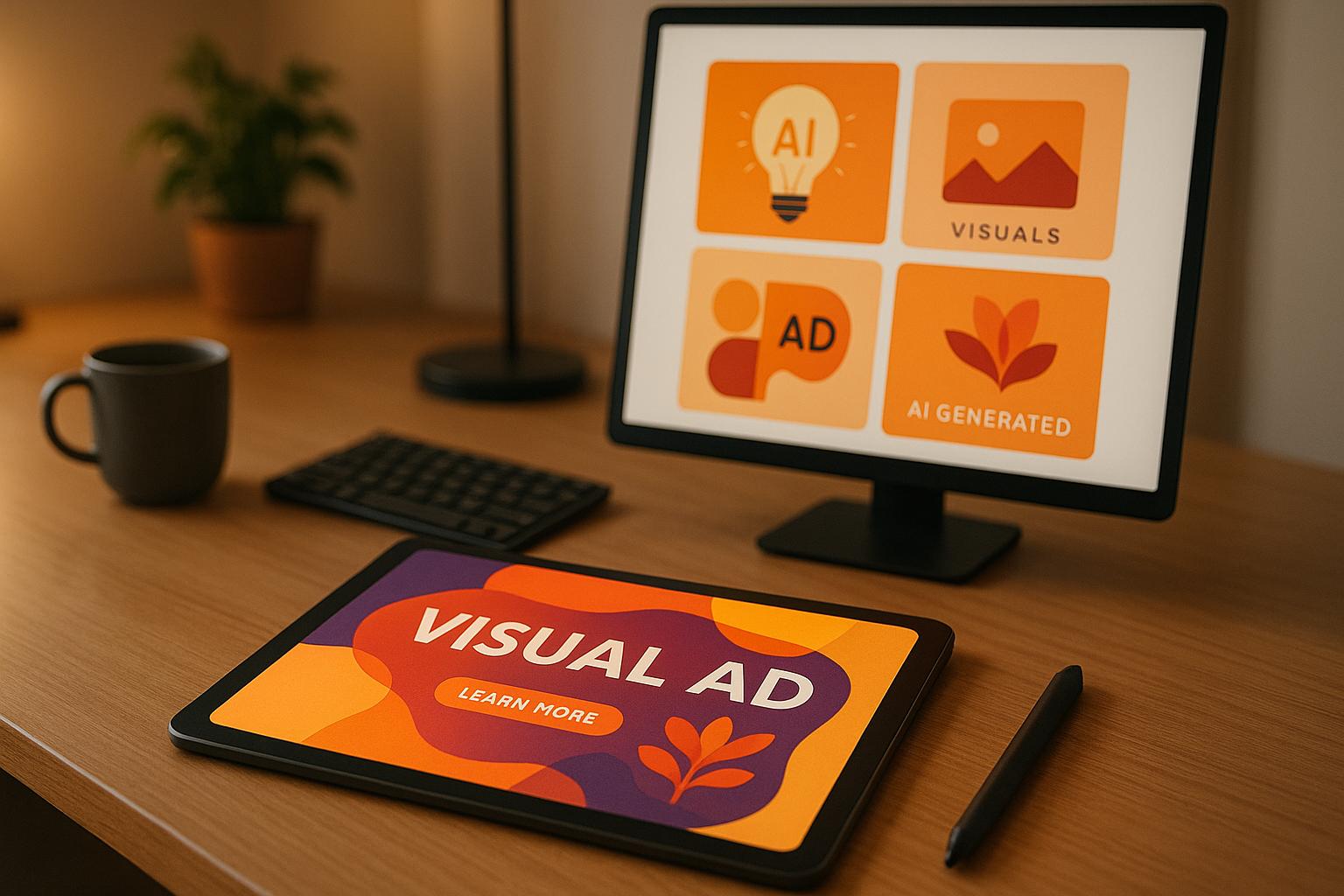AI Ad Copy Tools for Google, Meta, and Microsoft Ads
AI tools for ad copywriting are transforming digital advertising in 2025. They help businesses save time, improve targeting, and increase conversions across platforms like Google, Meta, and Microsoft Ads. Here's a quick overview of what each platform offers:
- Feedcast: Centralized AI platform for managing multi-channel ad campaigns, tailored for e-commerce. Key features include personalized ad copy, platform-specific optimization, and real-time analytics.
- Google Ads: Focuses on search intent with tools like AI Max and Smart Bidding, delivering higher conversion rates and better ROI.
- Meta Ads: Excels in real-time personalization for Facebook and Instagram, leveraging AI for tailored visuals and audience targeting.
- Microsoft Ads: Uses Copilot and Performance Max for conversational targeting, optimized bids, and professional audience reach.
Quick Comparison
| Platform | Key Feature | Best For |
|---|---|---|
| Feedcast | Multi-channel management | E-commerce businesses |
| Google Ads | Search intent optimization | Search-based advertising |
| Meta Ads | Real-time personalization | Visual and social media campaigns |
| Microsoft Ads | Conversational targeting | Professional and niche audiences |
AI tools are cutting ad creation time, improving ROI, and making campaigns more efficient. If you're in e-commerce or digital advertising, these tools are worth exploring to stay competitive.
Transform Your Google Ads Copywriting with AI and a Simple Template
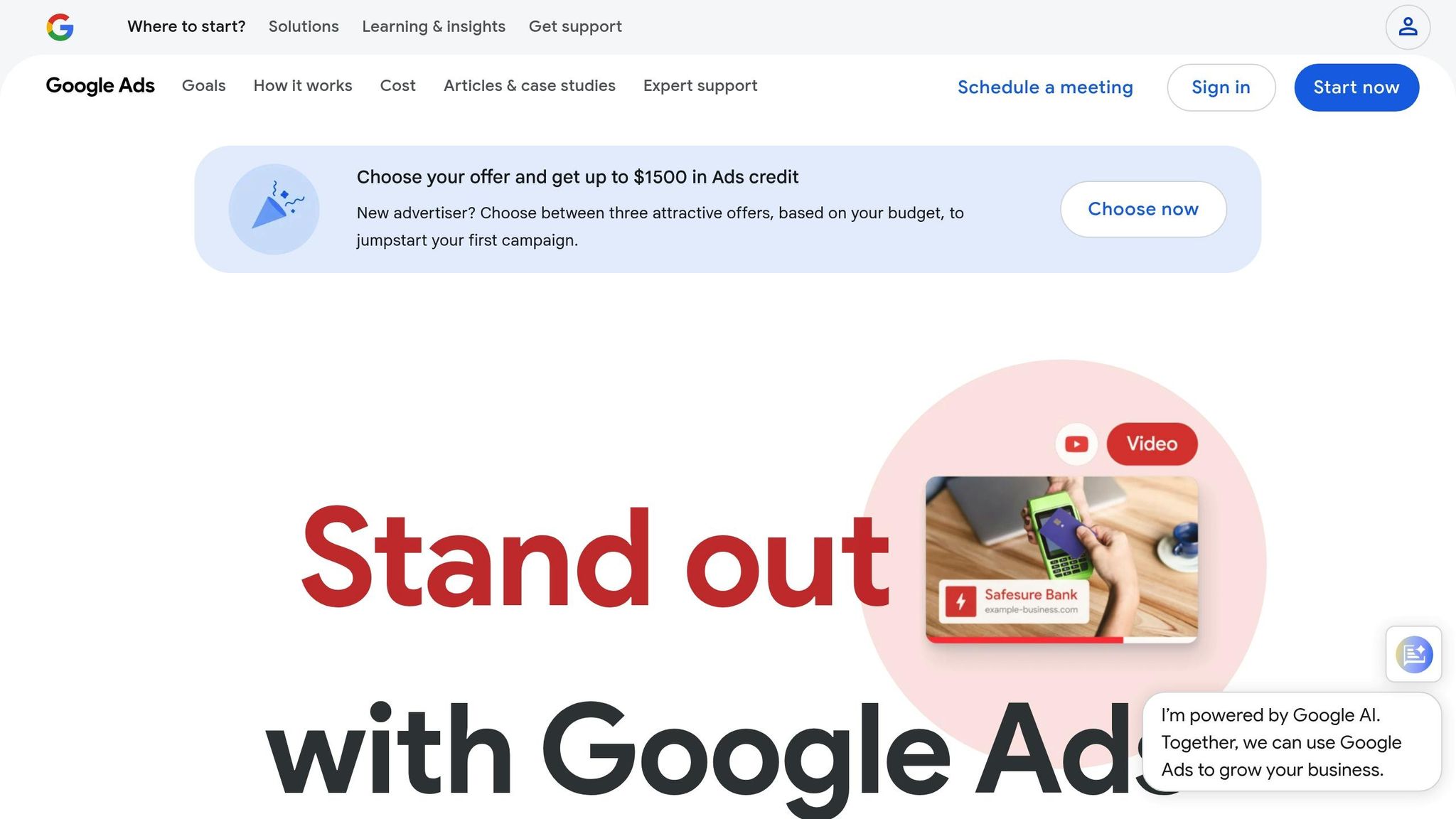
1. Feedcast
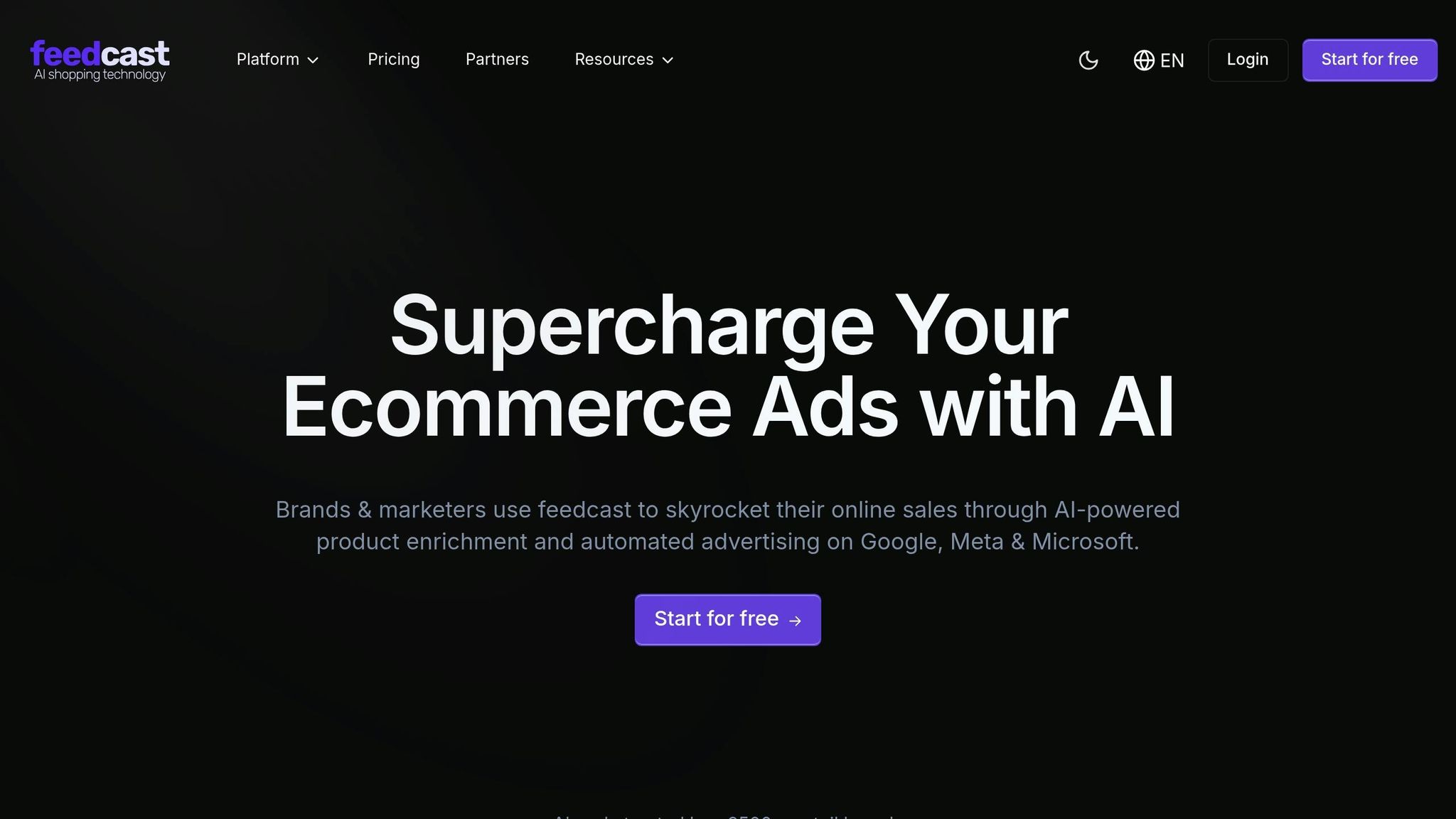
Feedcast is an AI-driven platform designed to help e-commerce businesses streamline their advertising efforts across multiple channels. From Google and Meta to Microsoft Ads, Feedcast enables users to manage and optimize campaigns from a single dashboard. With over 2,500 e-commerce brands on board and more than $133 million in sales generated through the platform, it’s clear that Feedcast has made a significant impact in the advertising space [3]. Let’s take a closer look at how Feedcast uses AI to enhance ad copy and optimize campaigns for different platforms.
Ad Copy Personalization
Feedcast's AI doesn’t just fill in templates - it crafts tailored ad copy for each advertising channel [2]. By analyzing your product data, it creates headlines, descriptions, and calls-to-action that align with the unique requirements of platforms like Google, Meta, and Microsoft Ads. For instance:
- Google Ads: The AI generates search-optimized copy packed with relevant keywords.
- Meta Platforms: The focus shifts to eye-catching, visually engaging messaging that encourages social interaction.
- Microsoft Ads: Copy is tailored to appeal to the professional audience often found on Bing.
What sets Feedcast apart is its ability to learn continuously. By drawing insights from your product catalog, brand voice, and campaign performance, the platform refines its output over time, ensuring your ads remain sharp, targeted, and effective - without requiring constant manual tweaks.
Platform-Specific Optimization
Feedcast’s standout feature is its ability to adapt product data for each advertising platform automatically. Instead of manually creating multiple versions, the platform adjusts titles, descriptions, and attributes to fit the specific needs of each channel [2].
- Google Shopping: Detailed specifications and competitive pricing are key.
- Meta Platforms: Lifestyle-driven descriptions paired with compelling imagery drive engagement.
- Microsoft Ads: Feature-focused copy appeals to business-oriented users.
Feedcast ensures that a single product entry is transformed into multiple, platform-optimized versions, saving time while maximizing impact.
Analytics and Reporting
With Feedcast, tracking ad performance is simple and efficient. The platform provides a unified dashboard that displays real-time metrics and offers customizable reports. These analytics allow you to:
- Compare performance across channels.
- Identify which platforms deliver the best return on investment.
- Segment performance by product category, platform, and other factors.
This level of insight helps businesses make data-driven decisions, from adjusting marketing budgets to prioritizing specific inventory. Plus, these analytics integrate seamlessly with Feedcast’s e-commerce systems, creating a feedback loop that drives continuous improvement.
Integration with E-commerce Platforms
Feedcast’s ability to integrate with a wide range of e-commerce platforms ensures that your product data stays accurate and up-to-date across all advertising channels. Here are some of the integration options:
| Platform Integration Options |
|---|
| Shopify |
| WooCommerce |
| PrestaShop |
| Webflow |
| WiziShop |
| Google Sheets |
| CSV Files |
| TXT Files |
| XML Files |
These integrations make it easy to connect your existing e-commerce setup without disrupting your workflow. Feedcast automatically syncs product details, ensuring that your campaigns always reflect the latest inventory, pricing, and updates.
The platform offers flexible pricing plans to suit businesses of various sizes. The Free plan supports up to 1,000 products and allows ad account connections. The Autopilot plan, at $99 per month, manages up to 1,000 products across multiple channels. For larger businesses, the Premium plan, priced at $249 per month, offers unlimited products and channel connections [3].
2. Google Ads AI Features
As businesses embrace AI-powered multi-channel strategies, Google has stepped up its game by integrating advanced AI features into its advertising platform. These tools are designed to help brands connect with the right audience, deliver tailored messages, and maximize their return on ad spend.
Ad Copy Personalization
Google's AI Max for Search campaigns takes ad personalization to a new level. Using AI, it creates ad copy that aligns with user search behaviors and intent [5]. Alongside this, Automatically Created Assets (ACA) analyze landing pages, generating relevant text and images while optimizing ads in real time [4]. This ensures users see ads that match their intent and are directed to the most effective landing pages on your site [5].
Additionally, Google is experimenting with a Conversational experience feature, allowing select advertisers to craft ad copy through natural language interactions in the ad creation interface [4].
The results speak for themselves. For instance, L'Oréal achieved a 2X higher conversion rate while reducing their cost-per-conversion by 31%. They tapped into new search queries like "what is the best cream for facial dark spots?" to drive these results [8].
"AI Max not only allowed us to pioneer the use of AI in Search - it also propelled us into new markets, reaching untapped audiences with lower costs, higher conversions, and more relevant ad experiences that significantly boosted engagement." - Nicolás Moya, CMO, L'Oréal Chile [8]
These AI-driven assets not only personalize ad experiences but also enhance bidding and placement strategies across Google's ecosystem.
Platform-Specific Optimization
Google's AI tools excel at optimizing campaigns within its ecosystem. For example, Smart Bidding Exploration helps advertisers identify high-performing search opportunities beyond traditional keyword targeting [7][10].
In e-commerce, Google's AI simplifies Shopping Campaigns by managing product listings, displays, and optimizations to drive better sales [9]. These tools enable businesses to present their products effectively to potential buyers.
A case in point is MyConnect, an Australian utility connection service. By leveraging AI Max in their Search campaigns, they achieved 16% more leads, reduced cost-per-action by 13%, and saw a 30% boost in conversions from new search queries [8].
"With the AI-powered creative and targeting enhancements in AI Max for Search campaigns, we were able to drive incremental high-quality leads by unlocking net-new searches and having AI build more relevant content to each user and their query." - Bec Oxnam, Head of Marketing, MyConnect [8]
Advertisers using AI Max in Search campaigns typically experience 14% more conversions or conversion value at a similar cost-per-acquisition (CPA) or return on ad spend (ROAS). For those relying on exact and phrase keywords, the uplift can reach 27% [8].
Analytics and Reporting
Google's AI doesn't just create ads - it also delivers actionable insights. The Google Ads report generator uses AI to produce detailed performance reports, helping businesses analyze data and refine their strategies [6]. Campaigns using Smart Bidding Exploration, for example, see an average 18% increase in unique search queries with conversions and 19% more conversions overall [10].
Integration with E-commerce Platforms
Google's Merchant Center Next leverages AI to simplify tasks, provide analytics, and personalize the experience for e-commerce businesses [11]. It seamlessly integrates with platforms like Shopify, WooCommerce, and BigCommerce, making it easier to upload and update product catalogs [11]. These integrations enhance efficiency, especially for platforms managed through tools like Feedcast.
Google's AI capabilities extend across various campaign types, including Search, Performance Max, Display, Shopping, Video, and App ads [12]. The platform also works with essential tools like Google Analytics, Salesforce, HubSpot, WordPress, Zapier, and Magento, ensuring smooth workflows [13].
For small businesses, AI tools make a noticeable difference. Advertisers are 63% more likely to achieve 'Good' or 'Excellent' Ad Strength when using the conversational experience in Google Ads [14]. Adding Demand Gen to Search or Performance Max campaigns has also resulted in 14% more conversions [14].
Ultimately, success with these AI tools requires thoughtful preparation. As one expert puts it:
"Think of AI as a content expander, not a content creator." [4]
This means starting with strong landing pages, clear URLs, and well-crafted manual assets that highlight keywords, product benefits, and brand identity [4].
3. Meta Ads AI Features
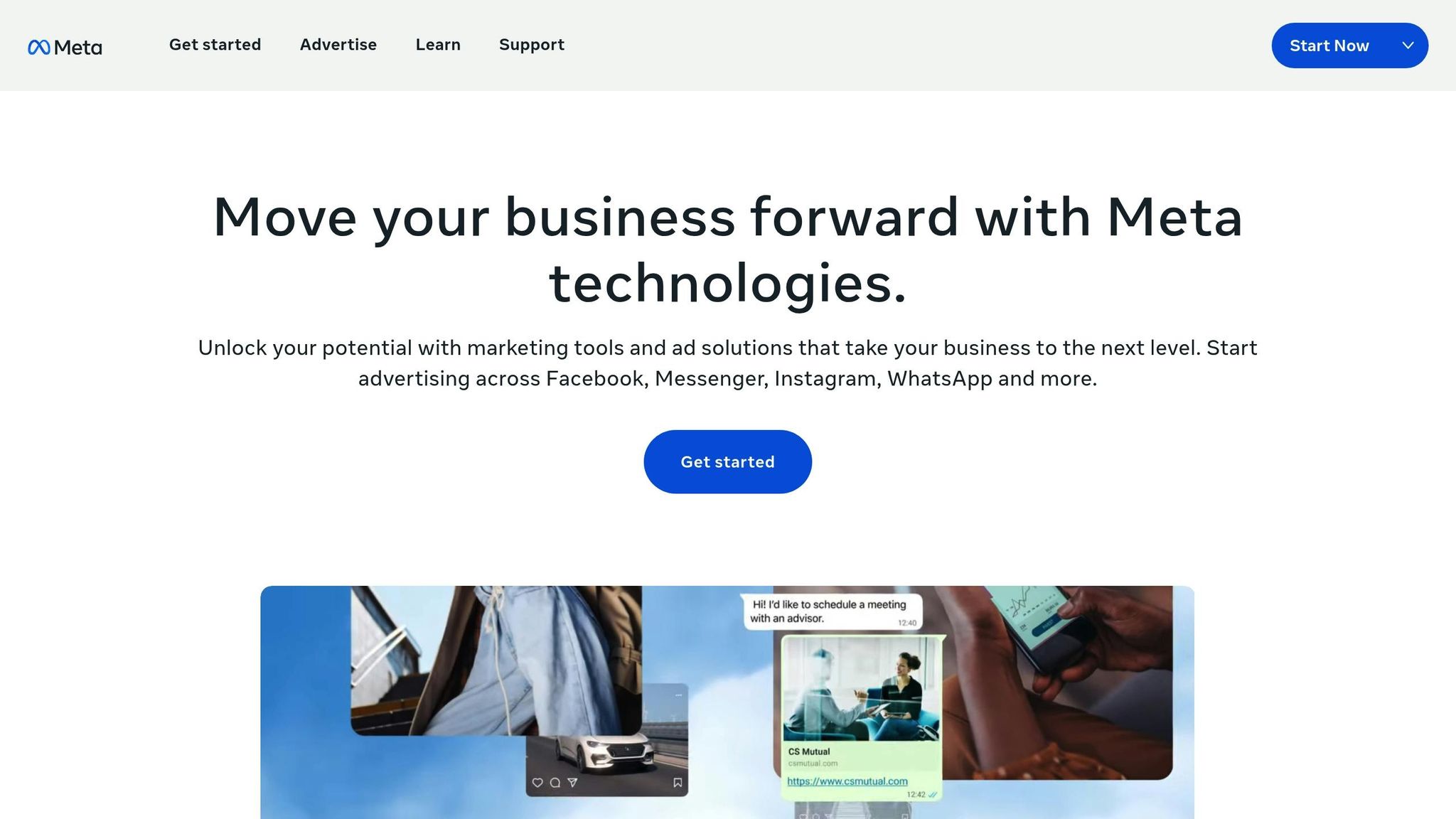
Meta has reshaped the way advertising works on Facebook and Instagram by introducing advanced AI systems that create highly personalized experiences for users. Mark Zuckerberg himself described this as "a redefinition of the category of advertising" [16].
Ad Copy Personalization
Meta’s AI doesn’t just target users; it personalizes ads in real time, tailoring content based on user behavior and location [15]. This is made possible through three key AI tools:
- Meta GEM: Analyzes how users respond to ads.
- Meta Lattice: Decides how different ad types are shown to each user.
- Meta Andromeda: Learns individual preferences to deliver relevant promotions.
By combining these tools, Meta’s AI fine-tunes ad elements like location-specific messaging, leading to a 22% boost in ROAS (Return on Ad Spend) in Q1 2025 [16] [19].
Take the fashion brand ONE BOY, for example. They added an Advantage+ shopping campaign to their strategy and saw impressive results: 42% more purchase events, a 34% increase in ROAS, and a 29% drop in customer acquisition costs [17]. Meta’s research also highlighted that small, personalized tweaks to images can drive 14% more incremental purchases [17].
"AI has already made us better at targeting and finding the audiences that are interested in their products than many businesses are themselves. And now, AI is generating better creative options for many businesses as well." - Mark Zuckerberg, CEO of Meta [18]
Platform-Specific Optimization
Meta is on track to fully automate ad creation by 2026 [16]. The platform’s AI handles everything from drafting ad copy to designing creatives, segmenting audiences, and even recommending budgets [21].
One standout feature is Value Optimization, which lets marketers prioritize campaign outcomes based on the value they assign to different customer actions [20]. Additionally, Value Rules in Ads Manager allow advertisers to assign higher value to specific customer types [20].
In Q1 2025, this approach paid off with a 5% year-over-year increase in ad impressions and a 10% rise in the average price per ad [21]. These automated tools not only improve efficiency but also integrate seamlessly with e-commerce platforms, ensuring campaigns are data-driven and outcome-focused.
"Our goal is to make it so that any business can basically tell us what objective they're trying to achieve, like selling something or getting a new customer, and how much they're willing to pay for each result, and then we just do the rest." - Mark Zuckerberg, CEO of Meta [18]
Analytics and Reporting
Meta’s AI has significantly improved content recommendations, increasing time spent on Facebook by 7%, Instagram by 6%, and Threads by 35% [18].
Advertisers using omnichannel ads saw a 15% reduction in omnichannel CPA (Cost Per Acquisition) and a 12% boost in media ROAS, compared to standard campaigns [25]. These analytics-driven insights empower marketers to refine their strategies for better results.
Integration with E-commerce Platforms
Meta’s AI simplifies integration with e-commerce platforms, enhancing catalog ads and streamlining payment experiences. This has led to returns improving by up to 22% [22]. The platform is also experimenting with generative AI for features like background and text generation for catalog ads [22].
Shops ads, powered by AI, work with Advantage+ campaigns to identify users most likely to make purchases directly within Facebook or Instagram stores [23]. Meta is also testing a smoother checkout process, where users can add items to their cart in-app before completing the purchase on the advertiser’s website [23].
For instance, American Eagle achieved a 48% higher ROAS with their core audience of 18-24-year-olds by leveraging omnichannel ads [23] [25]. Their Chief Marketing Officer, Craig Brommers, shared:
"We were able to achieve a 48% higher return on our omnichannel ads with our target audience of 18-to 24-year-old shoppers. We are excited about these results and will incorporate this strategy into our campaigns." [23]
Meta is also enhancing Partnership Ads with Advantage+ catalog ads, combining influencer content with AI-driven personalization. Zepto, for example, saw an 18% reduction in CAC (Customer Acquisition Cost) and a 33% increase in CTR (Click-Through Rate) when using these features [26].
Additionally, Nissan tested site links in Europe and achieved a 39% rise in landing page views and a 19% increase in qualified site visits [25]. Campaigns leveraging Meta’s generative AI tools recorded an 11% higher CTR and a 7.6% boost in conversion rates, proving how AI can deliver better engagement and results [24].
These examples showcase how Meta’s AI-powered advertising tools are driving smarter, more efficient campaigns for e-commerce businesses across its platforms.
sbb-itb-0bd1697
4. Microsoft Ads AI Features
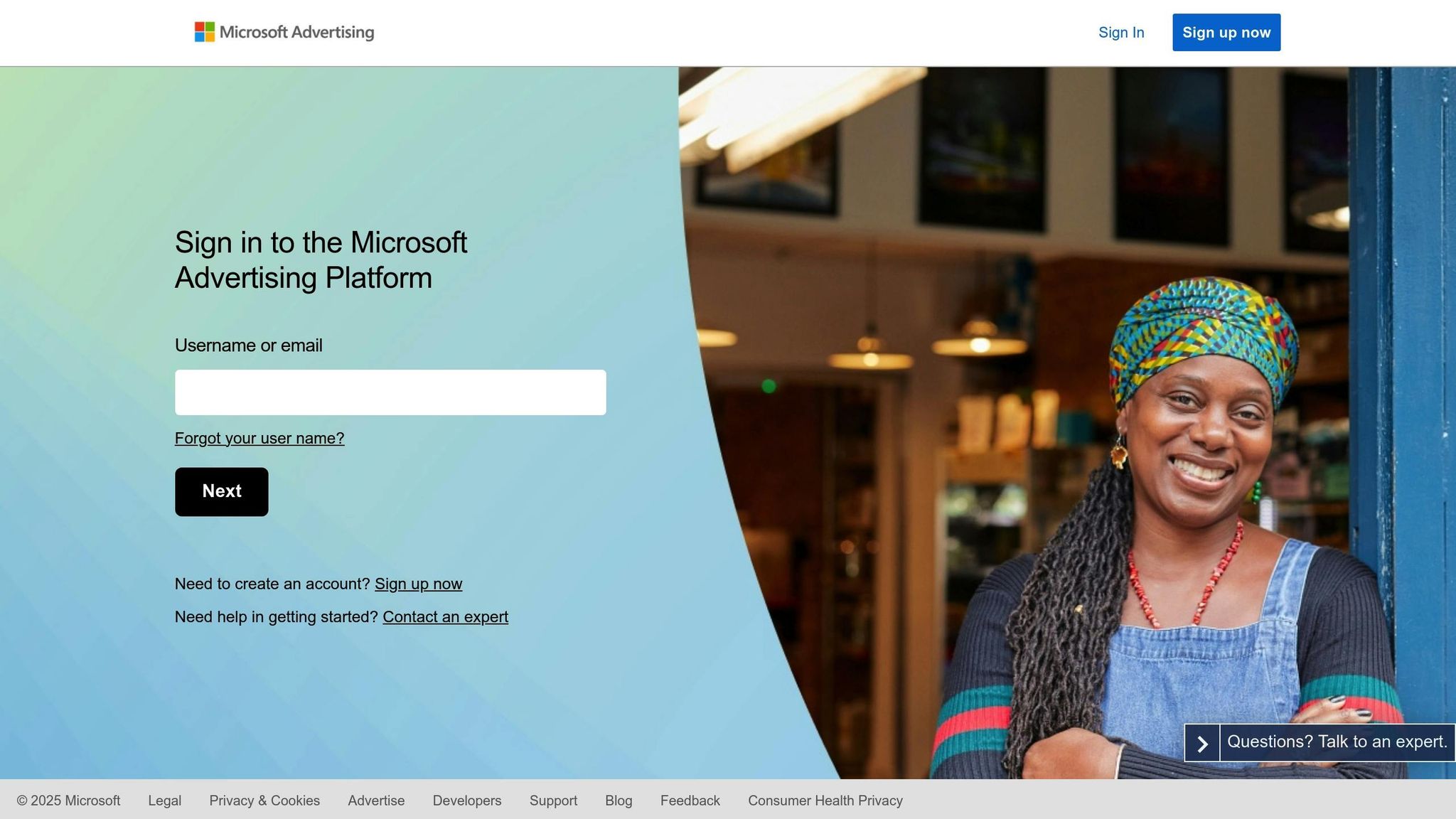
Microsoft Ads, like other leading platforms, employs advanced AI strategies to improve ad performance across its network. By combining tools like Copilot with extensive audience reach, Microsoft Ads delivers impactful results. The platform connects with 221 million people in the U.S. who aren’t on Pinterest, 125 million not on Instagram, and millions more who avoid Google, Facebook, or Amazon [27].
Ad Copy Personalization
Microsoft's AI-driven ad system boosts relevance by 25% compared to traditional search ads [29]. Since its November 2024 relaunch, Copilot has driven a 1.3x increase in ad conversions across all formats [29]. Ads powered by Copilot achieve 69% higher click-through rates and 76% higher conversion rates for lower-funnel campaigns compared to standard search ads [30].
This success stems from Microsoft’s use of advanced natural language processing and intent analysis. By studying user behavior, the platform crafts highly targeted ad copy that aligns with customer needs at every stage of their journey.
Platform-Specific Optimization
Microsoft Ads offers AI-powered tools designed for seamless optimization. For example, Performance Max campaigns use machine learning to automatically refine bids, targeting, and creative elements across Microsoft’s network, which includes Bing, MSN, and partner sites. Additionally, the platform provides advanced bidding strategies like Enhanced CPC, Maximize Conversions, Target CPA, and Target ROAS. Integration with LinkedIn allows advertisers to target audiences based on professional profiles.
With Copilot, Performance Max campaigns see 1.7x higher click-through rates, while overall AI efforts increase click-through rates by 1.5x, speeding up customer journeys by over 30% [27]. Microsoft’s audience also stands out: they are 49% more likely to have high incomes and 20% more likely to make purchases [27]. These tools enable advertisers to make fast, data-driven decisions for campaign success.
Analytics and Reporting
Microsoft Ads has elevated its reporting capabilities with AI-driven insights. Reports are now generated 60% faster, allowing advertisers to access critical performance data more efficiently [32]. The addition of Copilot to Microsoft Advertising, announced in April 2024 [1], further enhances this experience. Acting as an AI assistant, Copilot provides a performance summary that highlights key trends, anomalies, and actionable insights. It even offers real-time answers to account-specific questions and recommendations for campaign optimization [31].
Integration with E-commerce Platforms
Microsoft Ads also excels in integrating with e-commerce platforms, offering features like AI-powered campaign recommendations and Household Attribution. The latter tracks cross-device interactions, giving businesses a clearer view of the customer journey [28]. Over time, the AI adapts based on campaign performance, delivering increasingly refined suggestions. As Microsoft puts it:
"The more your team uses AI tools, the more intuitive and impactful the results will be." [29]
For e-commerce brands, starting with Performance Max campaigns provides automated insights that improve as campaigns progress, making it easier to achieve better results over time.
Comparison of Features
AI is reshaping advertising across platforms, and this section dives into how key players stack up. By understanding these differences, advertisers can align each platform's strengths with their campaign goals.
Feedcast stands out as a go-to tool for e-commerce businesses juggling multiple ad channels. Its major advantage lies in simplifying product feed management while offering a centralized dashboard to monitor performance across Google, Meta, and Microsoft Ads. However, its focus is specifically on retail, making it less suitable for service-based or intricate B2B campaigns.
Google Ads AI tools are built for optimizing conversions and aligning with search intent. Features like Performance Max campaigns and Smart Bidding have shown impressive results, such as cutting content creation time by 30–50% and boosting campaign engagement rates by 33% [33].
Meta's AI capabilities shine in real-time personalization, particularly in optimizing visual content. During Q1 2025, Meta reported a 5% year-over-year increase in ad impressions and a 10% rise in average ad prices, driven by AI-enhanced performance [21]. As Mark Zuckerberg explained:
"AI is now generating better creative options and helping businesses drive measurable results at scale" [21].
Microsoft Ads focuses on conversational targeting, using AI-powered tools like Copilot on Bing and Edge to deliver more natural, dialogue-driven ad experiences [34].
| Platform | Key Strength | Ideal For |
|---|---|---|
| Feedcast | Unified multi-channel management | Online stores managing multiple ad platforms |
| Google Ads | Conversion optimization & search intent | Businesses focusing on search-based advertising |
| Meta | Real-time personalization in visuals | Brands emphasizing visual storytelling |
| Microsoft Ads | AI-driven, conversation-based targeting | Advertisers exploring conversational ads |
Feedcast starts at $99 per month, while Google, Meta, and Microsoft rely on various pay-per-click pricing models.
Beyond ad creation, each platform offers unique integration tools to simplify campaign management. Feedcast enriches e-commerce data with AI, Google pairs seamlessly with its suite of services like Analytics, Meta includes pixel tracking and catalog features, and Microsoft leverages AI within the Bing and Edge ecosystems.
Analytics and reporting also vary. Feedcast provides a unified dashboard that breaks down performance by product category and platform, helping retailers identify top-performing products. Google Ads offers detailed conversion tracking, though it requires some technical setup. Meta focuses on visual performance metrics and deep audience insights.
The right choice depends on your business model and target audience. E-commerce businesses may gravitate toward Feedcast's all-in-one solution, while others might find the specialized features of Google, Meta, or Microsoft better suited to their needs. These distinctions allow advertisers to pick the AI tool that aligns best with their unique goals.
Conclusion
AI-powered ad tools have reshaped the digital advertising landscape, delivering measurable benefits like boosting conversion rates by up to 73% and tripling campaign profitability [35]. These advancements are not just theoretical - they’re making a real difference for major brands.
Take Procter & Gamble, for instance. Their AI-driven ad solutions increased sales conversions by 20% while cutting ad management time by 60% [35]. Similarly, Coca-Cola leveraged AI for targeted advertising, achieving a 3% sales growth and hitting $12.4 billion in revenue between April and June 2024 [36]. These examples highlight how AI isn’t just a trend - it’s becoming a cornerstone of effective advertising strategies.
"The future of paid advertising lies not in reaching more people, but in reaching exactly the right people with exactly the right message at exactly the right time. AI makes this level of precision possible." – Eric Siu, CEO of Single Grain [35]
For e-commerce brands already using AI across platforms, tools like Feedcast amplify these benefits. With its unified dashboard, AI-driven product enrichment, and automated management features, Feedcast helps streamline campaigns while enhancing performance [3].
What truly sets successful businesses apart is not just adopting AI but integrating it seamlessly into their unique marketing strategies. Centralized solutions like Feedcast allow advertisers to manage campaigns across multiple platforms efficiently, ensuring cohesive messaging and optimized results. This approach is gaining traction, with 30% of agencies, brands, and publishers fully incorporating AI into their campaign lifecycles by 2025 [35].
The shift toward AI-driven advertising is undeniable. From reducing management time by up to 60% [35] to increasing click-through rates by 1.7x [27], the advantages are clear. Businesses that delay adopting AI risk falling behind competitors already reaping these rewards. The message is simple: choose AI tools that align with your goals and start transforming your advertising strategy today.
FAQs
How does AI make ad copy more personalized for platforms like Google, Meta, and Microsoft Ads?
AI takes ad copy personalization to the next level by leveraging advanced data analysis and automation. It dives deep into user behavior, preferences, and demographics to create ad messages that truly connect with specific audiences while staying true to the brand’s voice. Plus, it can churn out multiple ad variations in no time, fine-tuning them to boost engagement and drive conversions.
Using natural language processing (NLP), AI ensures that the tone and messaging hit the mark, making the content feel relevant and impactful. On top of that, AI tools sharpen targeting strategies, helping businesses deliver ads to the right people at just the right moment. The result? Campaigns that grab attention, deliver stronger results, and save time - all while maximizing ROI.
What makes Feedcast a valuable tool for managing e-commerce ad campaigns across multiple platforms?
What Does Feedcast Do?
Feedcast streamlines multi-channel e-commerce advertising by giving you one platform to manage campaigns across Google, Meta (Facebook and Instagram), and Microsoft Ads. It uses AI to craft platform-specific ad copy, helping boost engagement and performance.
With Feedcast, you can easily reach new customers, reconnect with past ones, and fine-tune your campaigns using real-time analytics. As a Google CSS Partner, it also offers cost-saving perks for Google Shopping campaigns, helping you get more out of your ad spend. By automating tasks like managing product feeds and creating ads, Feedcast not only saves you time but also improves product visibility and campaign outcomes.
How can businesses use AI advertising tools to improve their e-commerce campaigns?
Businesses looking to elevate their e-commerce campaigns can benefit significantly from incorporating AI-powered advertising tools into their existing systems. These tools handle time-consuming tasks like creating ad copy, targeting specific audiences, and tracking performance - streamlining processes and boosting productivity. For instance, platforms such as Feedcast.ai can craft custom ad copy tailored to various channels, driving better engagement and increasing conversions.
AI tools also excel at analyzing customer data to deliver personalized experiences, helping brands connect more effectively with their audience and build lasting customer relationships. On top of that, they offer real-time performance insights, enabling businesses to tweak campaigns on the fly to maximize ROI. By integrating seamlessly with current e-commerce platforms, these tools make multi-channel advertising easier and more effective, leading to better marketing outcomes overall.
Yohann B.

